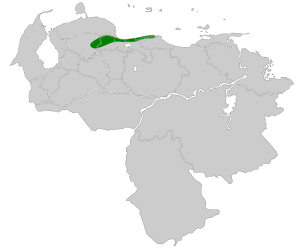Scallop-breasted antpitta facts for kids
Quick facts for kids Scallop-breasted antpitta |
|
|---|---|
| Conservation status | |
| Scientific classification | |
| Genus: |
Grallaricula
|
| Species: |
loricata
|
 |
|
The scallop-breasted antpitta (Grallaricula loricata) is a small, shy bird that lives in the forests of Venezuela. It belongs to a family of birds called Grallariidae, known as antpittas. These birds are often hard to spot because they live on the forest floor and are very good at hiding.
This special bird is found only in one specific area: the Venezuelan Coastal Range. This means it is an endemic species, which means it lives naturally in only one place in the whole world. Its home is in moist montane forest, which are forests found on mountainsides. Sadly, the scallop-breasted antpitta is facing a big problem: its home is shrinking because of habitat loss.
Contents
What is a Scallop-breasted Antpitta?
The scallop-breasted antpitta is a small bird, usually about 10 to 12 centimeters (4 to 5 inches) long. It gets its name from the unique pattern on its chest, which looks like scallops or scales. This pattern helps it blend in with the leaves and shadows on the forest floor.
What Does It Look Like?
This bird has a mostly olive-brown back and head. Its belly is often a lighter color, and its chest has those distinct dark "scallops" on a lighter background. It has a short tail and strong legs, which are perfect for hopping around on the ground. Its eyes are usually dark, and it has a small, pointed beak.
Where Does It Live?
The scallop-breasted antpitta prefers to live in the cool, damp forests high up in the mountains. These are called subtropical or tropical moist montane forests. It likes areas with lots of undergrowth, fallen leaves, and mossy trees. This dense plant life provides good cover from predators and a rich hunting ground for food.
What Does It Eat?
Like other antpittas, the scallop-breasted antpitta mainly eats insects and other small invertebrates. It spends most of its time foraging on the forest floor, carefully searching through leaf litter and moss. Its diet likely includes ants, beetles, spiders, and other small creatures it can find among the plants and soil.
How Does It Behave?
These birds are known for being very secretive. They are often heard before they are seen. Their calls are usually simple and repetitive, helping them communicate with other antpittas in the dense forest. They tend to stay close to the ground, hopping rather than flying long distances. When they do fly, it's usually short bursts between trees or bushes.
Why Is This Bird in Danger?
The biggest threat to the scallop-breasted antpitta is the loss of its natural home. People are cutting down forests for farming, building, and other activities. When the forests disappear, these birds lose their food sources, their nesting sites, and their safe places to hide. Because this bird lives only in a small area of Venezuela, losing even a small part of its habitat can have a big impact on its population.
Protecting Their Home
Conservation groups and scientists are working to protect the scallop-breasted antpitta and its habitat. This includes setting aside protected areas where forests cannot be cut down. It also involves educating local communities about the importance of these unique birds and their forest homes. Protecting these forests helps not only the antpitta but also many other plants and animals that live there.


